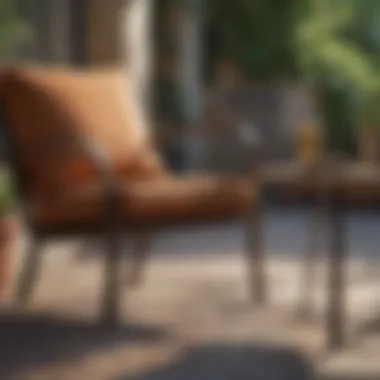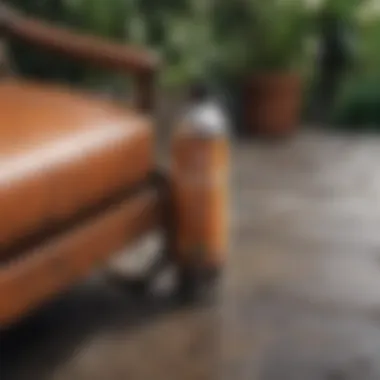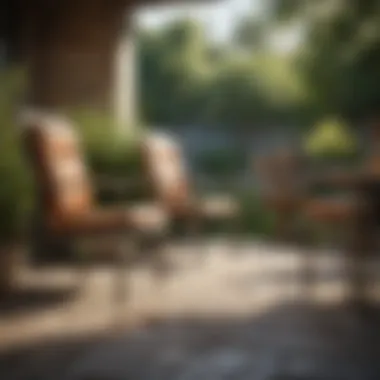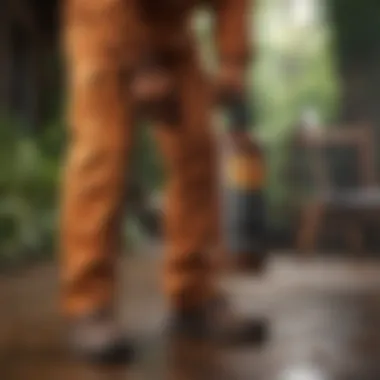Top Rust Removers for Outdoor Furniture Care


Intro
Outdoor furniture, despite its charm, is not immune to the invasive effects of rust. As seasons change, metal furniture can gradually accumulate rust, detracting from its aesthetic appeal and structural integrity. Understanding how to effectively remove rust can prolong the life of your furniture and maintain its visual allure. In this article, we will examine the best rust removers available on the market, explore various treatment techniques, and consider important factors that affect rust removal. This will help homeowners and outdoor enthusiasts keep their spaces not only functional but also inviting.
Effective Rust Removal Techniques
When tackling rust, various methods can be applied depending on the severity of the issue and the type of material used in the furniture. Let’s explore some prominent techniques:
- Mechanical Removal: Using tools like wire brushes or sandpaper can physically remove rust from surfaces. This method is labor-intensive but effective for severe rust cases.
- Chemical Rust Removers: There are specialized products designed to dissolve rust chemically. These can be efficient and require less manual effort. Notable examples include products like Evapo-Rust or Rust-Oleum Rust Dissolver.
- Homemade Solutions: A mixture of vinegar and baking soda can serve as a gentle remedy for small rust spots. Citric acid solutions also yield positive results without harsh chemicals.
"Consistent maintenance and prompt rust treatment can save outdoor furniture from accelerated deterioration."
Selecting the Right Product
Choosing a rust remover comes down to understanding the material of your furniture and the specific requirements for treatment. Consider the following:
- Metal Types: Aluminum, wrought iron, and steel each react differently to rust treatment. Ensure you choose a product compatible with your furniture's material.
- Safety Considerations: Some rust removers contain toxic chemicals that can be harmful to humans and pets. Opt for eco-friendly options if safety is a priority.
- Application Method: Evaluate the ease of use for each product. Some rust removers require brushing, while others can be sprayed directly on surfaces.
Maintenance Recommendations
To prevent rust from forming again after treatment, maintaining outdoor furniture is critical. Here are some proactive suggestions:
- Regularly clean furniture with mild detergent and water to remove dirt, which can trap moisture.
- Apply a protective coating, such as a clear sealant or paint, to shield the metal from environmental damage.
- Store furniture indoors or under cover during harsh weather conditions to minimize exposure to moisture.
By implementing these practices, one can ensure that outdoor furniture remains in good condition for years to come.
Understanding Rust on Outdoor Furniture
Rust is a significant concern for outdoor furniture, impacting both appearance and functionality. Understanding how rust forms and the various types of materials used in outdoor furniture is crucial for proper maintenance. It allows homeowners to make informed choices about rust removers and preventative measures. Without this knowledge, rust can lead to costly repairs or replacements.
Causes of Rust Formation
Rust formation is primarily caused by the reaction of metal with moisture and oxygen. When metal is exposed to these elements, it undergoes corrosion, leading to the familiar reddish-brown flakes we know as rust. External factors such as humidity, rainfall, and even salt in coastal areas can accelerate this process. It is especially common on items that are left outdoors for extended periods without protection.
Types of Outdoor Furniture Materials
Understanding the materials used in outdoor furniture is essential in combating rust effectively. Different materials respond to environmental factors in unique ways.
- Metal
Metal furniture is renowned for its durability and strength. However, it is also highly susceptible to rust, particularly if it lacks proper coating. The glossy finish on metal often masks rust when it first appears, making early detection challenging. Despite this, metal remains a popular choice for outdoor furniture due to its robust nature and longevity. The main disadvantage is its susceptibility to weather conditions, which necessitates regular maintenance and rust prevention measures. - Wood
Wooden outdoor furniture offers aesthetic appeal and warmth to outdoor spaces. Although wood does not rust, it can rot when exposed to moisture for too long. Wood demands a specific kind of care, including sealing and routine checks for damage. This makes it a popular yet demanding choice among homeowners who appreciate natural materials. The benefit of wood lies in its versatility in design, but the challenge is its vulnerability to the elements, requiring more frequent upkeep than metal. - Plastic
Plastic furniture has garnered popularity for its lightweight and easy-to-clean properties. It does not rust, which makes it a low-maintenance option for outdoor use. Its versatility in color and design also appeals to many homeowners. However, plastic can suffer from fading due to prolonged sun exposure and may become brittle in colder climates. Therefore, while it is excellent for rust concerns, its longevity in other aspects can be questioned. - Fabric
Fabric is commonly used in outdoor cushions and canopies. It does not rust but is vulnerable to mold and mildew if not properly cared for. Quality fabric can withstand outdoor conditions better than lower grade ones. The key characteristic of fabrics is their comfort and adaptability in outdoor settings. Nonetheless, this type of material requires regular cleaning and storage to extend its lifespan, making it a less practical choice compared to harder materials.
Significance of Rust Removal
Rust can be a detriment to outdoor furniture, affecting both its appearance and longevity. When you have outdoor pieces exposed to the elements, they are susceptible to moisture, which leads to rust formation, especially on metallic furniture. Understanding the significance of rust removal emphasizes the need to protect your investment.
Impact on Aesthetics
The visual appeal of outdoor furniture plays a considerable role in creating an inviting environment. Rust stains can ruin the aesthetic of your patio or garden. They can give a neglected impression, reflecting poorly on your home.
- Visible Damage: Rust not only looks unsightly but can spread if untreated. The longer it sits, the more of a blight it becomes. This can discourage you and your guests from using the space effectively.
- Color and Texture Change: Rust alters the original color and finish of the furniture. It can cause peeling and pitting, which detracts from the sleek lines of metal furniture.


In lighter colors, the contrast created by rust can be even more pronounced. Regular rust removal helps maintain cleanliness and aesthetic beauty.
Effects on Durability
The effects of rust on outdoor furniture extend beyond mere appearance.
- Structural Integrity: Rust can significantly weaken the material. With time, rust eats away at the metal, leading to structural failures. If the chair or table loses strength, it may collapse or break under weight, causing injury or damage.
- Cost of Replacement: Neglecting rust can lead to expensive replacements. Maintaining furniture is more cost-effective than purchasing new items. Those investment pieces deserve attention and care to ensure they last for years.
"Rust removal is not just beautification but a critical part of maintaining your furniture's functionality."
Criteria for Selecting a Rust Remover
Choosing the right rust remover for outdoor furniture requires careful consideration. It's essential to understand the specific needs based on the materials involved, the severity of the rust, and the intended use of the furniture after treatment. Selecting an appropriate rust remover can significantly impact the results, preserving the quality and appearance of your outdoor pieces.
Material Compatibility
Each type of material used in outdoor furniture interacts differently with rust removers. Metal furniture, commonly made from aluminum or steel, often requires specialized chemicals that can effectively target rust without causing further damage. Acid-based removers may work well on steel but can lead to surface corrosion on aluminum.
Wood furniture presents its challenges too. Many rust removers can be too harsh for wood, leading to discoloration or splintering. Hence, non-acidic formulations or natural alternatives are typically advisable to maintain integrity. For plastic or fabric materials, careful selection of rust removers is crucial. Some harsh chemicals can degrade the material, making it important to read product labels and choose carefully.
Ease of Use
A rust remover should not only be effective but also easy to apply. Time is valuable and the more user-friendly a product is, the more likely homeowners will use it properly. Many rust removers come in spray bottles or ready-to-use formulas, making the application process straightforward. It is beneficial that a remover can be applied with minimal tools—perhaps just a cloth or sponge.
In addition to ease of application, the time taken to see results matters. Fast-acting products can provide immediate satisfaction, which tends to be preferable for individuals looking to improve the aesthetics of their outdoor spaces quickly.
Environmental Considerations
As environmental awareness grows, using products that are less harmful to nature becomes increasingly important. Select rust removers that are biodegradable and have minimal environmental impact. Many brands now offer eco-friendly options that do not compromise on effectiveness while being safer for surrounding plants and wildlife.
Reading product labels helps to identify these environmentally conscious choices. Additionally, different methods, such as using vinegar or baking soda, align with a sustainable approach to rust removal. Choosing rust removers that consider environmental implications reflects a responsible model for maintaining outdoor furniture.
"Selecting the right rust remover is crucial for preserving your outdoor furniture and ensuring its longevity. Always consider the material compatibility, ease of use, and environmental impact when making your choice."
By adhering to these criteria for selecting a rust remover, homeowners can ensure they achieve the best possible results while maintaining the aesthetic and structural integrity of their outdoor furniture.
Types of Rust Removers
Understanding the different types of rust removers is crucial for effectively tackling rust on outdoor furniture. Each type has its unique properties and advantages, tailoring the treatment based on specific needs and preferences. By knowing the options available, homeowners can make informed decisions to preserve their outdoor investments. This section will explore the main categories of rust removers: chemical and natural alternatives.
Chemical Rust Removers
Chemical rust removers are popular due to their effectiveness in quickly dissolving rust. They come in two primary forms: acid-based and non-acidic. Choosing the right type can depend on personal preference, the extent of rust, and the material of the furniture.
Acid-Based
Acid-based rust removers utilize strong acids, such as hydrochloric acid or phosphoric acid, to break down rust. These products can be very effective at transforming rust into more manageable compounds, enabling easier removal. The key characteristic of acid-based removers is their high reactivity, which allows them to tackle tough rust stains that may be stubborn and deeply embedded.
One unique feature of acid-based options is their speed. They can provide quick results, making them an appealing choice for urgent restoration needs. However, these products can also be harsh on certain materials and may damage finishes or protective coatings. Careful testing on a small area is recommended before full application, especially on sensitive surfaces.


Non-Acidic
Non-acidic rust removers are often formulated with milder ingredients, focusing on safety and ease of use. Their key characteristic is their gentle action, which makes them a favored choice for delicate materials like painted surfaces or certain types of wood.
A unique feature of non-acidic formulas is their environmental friendliness. They tend to have lower toxicity levels and less impact on the surrounding area while still effectively combating rust. Despite this, non-acidic products might take longer to show results compared to their acid-based counterparts. Therefore, patience is often necessary when opting for this gentler approach.
Natural Alternatives
Natural alternatives to commercial rust removers are gaining popularity because they often use common household items. Not only do these options tend to be safer for users and the environment, but they can also be effective in removing rust.
Vinegar
Vinegar is a widely recognized household item used to combat rust. Its acetic acid content effectively breaks down rust and is suitable for various materials. The key characteristic of vinegar is its availability and cost-effectiveness, as many already have it in their kitchens.
One unique feature of using vinegar for rust removal is that it is less hazardous to both users and the environment compared to chemical-based products. However, while it is safe, it may require longer soak times to be fully effective, especially on heavy rust.
Baking Soda
Baking soda is another effective natural rust remover. It acts as a gentle abrasive, making it great for scrubbing rust off surfaces without scratching. The key characteristic of baking soda is its dual action as both a cleaner and a deodorizer, appealing for use on outdoor furniture.
A unique aspect of baking soda is its ease of preparation; making a paste with water is simple and requires minimal effort. Although effective on light rust, it may not suffice against severe rust scenarios, thus requiring homeowners to assess their situation before use.
In considering rust removers, it's crucial to evaluate both chemical options and natural alternatives to find the most suitable solution for specific needs. Understanding these types not only aids in effective rust treatment but also enhances the overall maintenance of outdoor furniture.
Best Rust Remover Products
When it comes to maintaining outdoor furniture, selecting the right rust remover is essential. Outdoor furniture faces various elements, leading to rust and deterioration over time. Choosing appropriate rust remover products can not only restore your furniture's appearance but also extend its lifespan. Effective rust removal protects your investment and keeps your outdoor space inviting.
Top Chemical Products
Chemical rust removers are widely available and often provide quick and effective solutions. These products are designed to react with rust, dissolving it and making removal easier. Some notable chemical products include:
- CLR (Calcium, Lime, and Rust Remover): This product is acclaimed for its efficiency against tough rust stains. It’s suitable for metal surfaces and can be used on various outdoor furniture.
- Evapo-Rust: Known for its non-toxic formulation, Evapo-Rust effectively eliminates rust without harming surrounding materials. It's safe for use on most metals, making it a popular choice.
- Rust-Oleum Rust Dissolver Gel: This gel formula clings to surfaces for extended contact time, enhancing its effectiveness. It’s ideal for vertical surfaces and intricate designs.
These products often contain acids or other chemicals aimed at breaking down rust. However, always read the label for specific usage instructions, safety precautions, and compatibility with your furniture's material.
Recommended Natural Solutions
For those who prefer eco-friendly alternatives, natural rust removers can be effective as well. Ingredients commonly found in households can serve this purpose. Two main options include:
- Vinegar: The acetic acid in vinegar helps dissolve rust. Soaking rusty items in vinegar or applying it directly can yield noticeable results. This method is often slower compared to chemical removers but is safer for both health and environment.
- Baking Soda: Creating a paste with baking soda and water can help scrub off rust. This method is non-toxic and suitable for most surfaces, although it might require more elbow grease than chemical options.
Using natural solutions is a great way to maintain safety while addressing rust problems. They are particularly beneficial for those handling furniture around pets or children.
"Natural solutions, while often slower, offer a non-toxic alternative that respects both health and the environment."
Step-by-Step Guide to Using Rust Remover
Using a rust remover is a precise process, requiring attention to detail. Proper application affects not only the effectiveness of the product but also the safety of the user and the integrity of the furniture. Following a structured approach will optimize results, ensuring that outdoor furniture is restored efficiently. This section outlines the critical steps to be taken during the rust removal process, addressing the necessary preparations and post-application practices.


Preparation Before Application
Before applying any rust remover, it is vital to gather the necessary materials. Here are the key things to prepare:
- Safety Gear: Always wear gloves and goggles. Rust removers, especially chemical ones, can be abrasive or harmful to skin and eyes.
- Work Area: Designate a well-ventilated outdoor area where overspray or drips will not cause damage. Cover adjacent surfaces and items with plastic sheeting or old newspapers.
- Tools: Ensure that you have a soft brush, scrubbing pads, or cloths on hand. More stubborn rust may require a wire brush.
- Rust Remover Selection: Choose a rust remover suited for the specific material of your furniture. Read the label carefully to confirm compatibility.
- Test Spot: Test the product on a small, inconspicuous area to observe any adverse reactions.
By taking these preparation steps, you set the stage for effective and safe rust removal.
Applying the Rust Remover
After preparations are in place, you are ready to apply the chosen rust remover. This segment can make or break the success of the task. Here's how to apply it correctly:
- Shake/ Stir the Product: If using a liquid rust remover, shake it well. For paste or gel formulations, ensure it is mixed thoroughly if needed.
- Application Method: Use a brush or cloth to apply a generous amount onto the rusted area. Avoid skimping on the product – a thicker layer ensures better penetration and effectiveness.
- Wait Time: Follow the manufacturer’s instructions on how long to let the product sit. Usually, it ranges from 10 to 30 minutes, depending on the formulation. Do not rush this step.
- Scrubbing: After the wait time, scrub the area gently. Use the soft brush or cloth to remove loosened rust. For tougher spots, a wire brush may be better, but be cautious not to damage the underlying material.
- Rinse: Thoroughly rinse the area with clean water to eliminate any residue. This step is crucial, as leftover chemicals can lead to further corrosion.
Proper application of rust remover is essential to the longevity and appearance of your outdoor furniture.
Post Removal Cleanup
Once the rust is removed and the area is rinsed, post-removal cleanup is necessary to finalize the process:
- Dry the Area: Use a clean towel to dry the treated area completely. Ensure no moisture remains, as this can cause new rust to form.
- Inspect for Remaining Rust: After drying, inspect the surface for any leftover rust spots. If needed, repeat the removal process on any stubborn remnants.
- Dispose Properly: Dispose of any used rust remover and cleaning materials as per local regulations. Do not pour chemicals down the drain unless labeled safe.
- Additional Care: Consider applying a protective coating or sealant once the surface is completely dried. This preventive measure can help mitigate future rust issues.
By following a detailed post-removal cleanup, you ensure a polished finish and safeguard your outdoor furniture against future rust formation.
Preventing Future Rust Problems
Preventing rust from forming on outdoor furniture is crucial for maintaining both its functionality and aesthetic appeal. Various strategies can significantly reduce the risk of rust, ensuring that the pieces remain attractive and durable for an extended period. Implementing these preventative measures can save homeowners from the hassle of frequent repairs and replacements. Rust not only compromises the integrity of materials but also detracts from the beauty of outdoor spaces.
Protective Coatings
Applying protective coatings is one of the most effective methods to prevent rust. These coatings act as a barrier between the metal and the elements that cause corrosion. There are several types of protective coatings available, including paints, sealants, and sprays. Each serves to shield the surface from moisture and other corrosive agents.
- Paints: Specialized rust-inhibiting paints are ideal for metal furniture. These paints often contain anti-corrosive properties that actively work against rust formation.
- Sealants: They offer a robust defense by filling in any small gaps where moisture can penetrate. A routine application of sealants can significantly extend the life of outdoor furniture.
- Sprays: Quick-drying and easy to apply, rust-proof sprays are perfect for furniture that needs touch-ups. They can be used year-round and provide a clear protective layer.
It is critical to choose a product that is compatible with the specific type of material used in the furniture. Ensure the surface is clean and dry before applying any coating to achieve optimal adhesion.
Proper Storage Techniques
Proper storage plays a significant role in rust prevention. Keeping outdoor furniture in a dry, sheltered environment can greatly reduce exposure to moisture. When it comes to effective storage techniques:
- Indoors: Whenever possible, store furniture indoors during adverse weather conditions. A garage or shed can provide an environment free from humidity.
- Covers: If indoor storage is not an option, consider using high-quality protective covers. These should be waterproof and breathable to prevent moisture accumulation.
- Elevating Furniture: Raised platforms or furniture pads can keep pieces above ground, reducing contact with damp surfaces.
In summary, maintaining outdoor furniture requires a proactive approach. Regularly applying protective coatings, paired with proper storage methods, can effectively decrease the risk of rust. By taking these steps, homeowners ensure that their outdoor spaces remain inviting, and their furniture stays in prime condition.
Culmination
The importance of rust removal from outdoor furniture cannot be overstated. As homeowners invest in their outdoor spaces, maintaining the aesthetic and functional aspects of their furniture is crucial. Rust not only detracts from the visual appeal but also shortens the lifespan of the furniture, making regular maintenance essential.
In this article, we covered various aspects related to rust removal, including the types of rust removers, both chemical and natural, and the criteria for selecting an effective product. Each element plays a significant role in ensuring that outdoor furniture remains both attractive and durable. Therefore, knowing how to choose the right rust remover tailored to specific materials can save time and money in the long run.
Besides product selection, we emphasized practical techniques for rust removal and prevention methods such as protective coatings and proper storage. These proactive measures are vital for overcoming the challenges posed by rust, especially in challenging outdoor conditions.
Ultimately, the goal is to foster a better understanding of maintaining outdoor furniture through effective rust management. By adopting the strategies discussed, homeowners can extend the life of their investments, enhance their outdoor experience, and ensure that their outdoor environments remain welcoming and enjoyable for family and guests.
"Maintaining your outdoor furniture is not just about aesthetics; it's about longevity and a good investment in your home."
It is recommended to review these guidelines periodically to stay updated on the best practices for rust prevention and removal. Proper maintenance will yield significant benefits, ensuring that outdoor spaces remain vibrant and ready for use.















